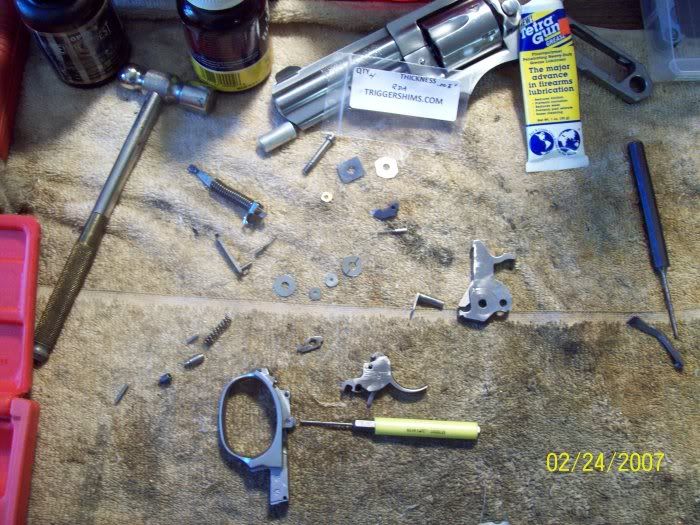I dont know of other revolvers but on this gp the cylinder stop stays in the up position when i load/unload. The only time itll go to down position is for a slight moment when you cock the hammer back and when used in DA.
I think I'm catching up... When you say cylinder stop, you're referring to the small "ear" that sticks up out of the frame in the bottom of the cylinder "window". It's the part that locks into the matching cuts around the outside of the cylinder--generally referred to as the bolt although Ruger calls that the "cylinder latch". I mistakenly thought you were referring to the cylinder release which Ruger calls the "crane latch".
Ok, so when you opened the cylinder, the cylinder latch stays in the down position. That is not normal behavior. It should only drop down briefly during cocking or during the double-action trigger pull.
There's really no connection between the crane assembly and the cylinder latch so what it sounds like is going on was that there was a small bit of debris/foreign material that was obstructing the normal movement of the cylinder latch. The fact that the problem went away after cleaning supports that theory.
The cylinder should not spin freely when it is latched into the frame, however, if the cylinder latch/bolt was hung in the down position, the cylinder would spin freely. So that's a normal consequence of something obstructing the normal movement of the cylinder latch.
Now that I feel reasonably sure I understand the problem, I feel pretty confident in saying that there was some sort of garbage that got inside the frame and managed to hang up on the cylinder latch. If the gun is working normally now, I'd probably be satisfied with doing a disassembly per the manual and inspecting the cylinder latch/bolt area to be sure that everything looks normal and that there are no burrs and no foreign material.
If you see nothing, put it back together and run the following checks (
PLEASE do them ONLY with the gun unloaded). If everything works properly, I'd say you're good to go.
Function/Safety checks for centerfire revolvers:
Verify cylinder rotation in single action. Cock the hammer and pull the trigger as many times as it takes to rotate the cylinder through 360 degrees—one full rotation. It shouldn’t bind or stick at all. If it does, check to insure that there is no fouling under the ejection star. If it still binds and the gun is clean, it needs the attention of a gunsmith.
Verify cylinder rotation in double action. If the revolver is double-action repeat the above test by ONLY pulling the trigger. Again the cylinder should go through a full rotation without binding or sticking. If it binds, check to insure that there is no fouling under the ejection star. If it still binds and the gun is clean, it needs the attention of a gunsmith.
Verify cylinder rotation with
dummy cartridges. If you have some
dummy/inert cartridges, repeat the above two tests with the
dummy/inert cartridges loaded into the cylinder and ensuring that the cylinder will rotate without binding or sticking. Empty cases can be used, but when I do this, I stuff a bit of wadded-up paper towel in each cartridge case to keep any fouling in the cartridge case from getting knocked out of the case and into the clean chambers.
Check timing in double action. If the revolver is double-action, pull the trigger very slowly and watch the cylinder. It should rotate all the way to a positive stop before the hammer falls. If the cylinder doesn’t “click/lock” into position before the hammer falls and still needs to be turned to reach the positive stop after the hammer is cocked, it needs the attention of a gunsmith.
Check timing in single action. Cock the hammer very slowly and watch the cylinder. It should rotate all the way to a positive stop by the time the hammer is cocked. If the cylinder doesn’t “click/lock” into position before the hammer locks into the cocked position and still needs to be turned to reach the positive stop after the hammer is cocked, then it needs the attention of a gunsmith.
Verify hammer and firing pin function in single action. Cock the hammer and drop a pencil down the barrel eraser end first. Pull the trigger. The pencil should jump very noticeably. Note that with repeated use, the pencil’s eraser will be damaged enough that it won’t work any longer.
Verify hammer and firing pin function in double action. If your revolver has a double-action trigger then slowly pull the trigger until the cylinder clicks positively into position and hold the trigger while you drop the pencil down the barrel. Finish pulling the trigger and be sure the pencil jumps very noticeably when the hammer falls. If the revolver fails this test it needs the attention of a gunsmith. Note that with repeated use, the pencil’s eraser will be damaged enough that it won’t work any longer.
Verify transfer bar/internal safety operation. When performing this test, insure that you release the hammer far enough forward that it doesn’t catch on the half-cock notch when you release it. Dropping the hammer on the half-cock notch repeatedly could damage the half-cock notch. Cock the pistol and put the pencil in the barrel eraser end first. Pull the trigger a little while holding the hammer until the hammer is free to move fully forward. Now release the trigger COMPLETELY and then let go of the hammer. The hammer should snap forward as if to fire the revolver but the pencil shouldn’t jump. If the pencil jumps then your revolver needs the attention of a gunsmith. Note that with repeated use, the pencil’s eraser will be damaged enough that it won’t work any longer.


